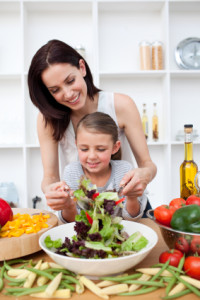 Have you ever wanted to plan a menu but had no idea how to really put a healthy meal together? Here is your opportunity to learn the basics of simple and healthy menu planning.
Have you ever wanted to plan a menu but had no idea how to really put a healthy meal together? Here is your opportunity to learn the basics of simple and healthy menu planning.
Because our lives’ are so busy, meal planning actually becomes an important tool to meet the basic requirements for good nutrition for your family. Learning to plan meals takes time and practice, but it’s an investment that will grow in value.
For some people, deciding what to eat five days from now seems overwhelming or boring. But planning meals is a great tool when it comes to healthful eating. Developing weekly meal plans and sticking to a shopping list helps keep stomachs from dominating food choices.
A good meal plan starts with a budget. When you plan a budget, you decide how much money to spend for food. Then the challenge for any family is to provide wholesome, enjoyable meals without spending more than the budget allows. To set up a food budget, simply find out how much your family is currently spending on food – keep your eating at home food budget separate from your eating out budget. You may keep records for a few weeks then calculate how much of your income you spend on food. At this point, a decision can be made to decide if current food expenses are acceptable or if you need to make any adjustments.
Top Ten Tools To Consider When Planning Meals:
Make a list — As you choose your recipes and prepare your weekly menus make sure you have all the necessary ingredients for each meal. This will make your grocery shopping more efficient and economical. And don’t forget to check the newspaper ads, online coupons, mobile ads, and flyers in order to get the best price for those items on your list.
Reducing food waste – Avoiding food waste starts by preparing food properly and at the right time. Recipes can be reduced for smaller families or appetites. Serving smaller portions also discourages overeating, while safe storage protects leftovers for future meals. To avoid wasting food, do a pantry, refrigerator and freezer check before writing your grocery list.
Savor the flavors — Use foods that are in season to get the best flavors at the best prices. Also, avoid using foods with familiar flavors in the same meal. For example, if you serve fruit salad with the main course, choose a dessert without fruit. Try to combine flavors that go together. This is when themes come in handy. Make a Mexican night, Big Game dinner, Asian dinner or left over night, etc. Using versatile, tasty and nutritious ingredients kids love, such as sauces, helps keeps children interested in even the healthiest meals.
Food groups – This should be your guide to making sure you are getting enough nutrients. Use the food guide pyramid to find out age appropriate portion sizes from each food group. For more information go to www.myplate.gov.
Skill Level – Successful meal planning takes advantage of each family member’s cooking skills. Less experienced cooks can contribute simpler steps, gradually learning more complicated techniques from more skilled family members. They can also learn important rules for kitchen safety and cleanliness. Families need to pool the time and energy available to each member and assign tasks based on who can do them most conveniently.
Colors – Choosing colorful fruits and vegetables helps to brighten a meal and add plenty of nutrients. To maximize the nutritional value of a meal, challenge your family to see how many colors you can include on your plate.
Shape and size – You can create different effects from a single food. You can slice a tomato vertically to form wedges or dice it for simple chewing.
Texture – How foods are prepared affect the way they feel when you chew. To add a healthy crunch, serve carrots raw instead of cooked. Toast bread to go with soup or top a casserole with bread crumbs.
Temperature – A food’s temperature affects its taste and texture, as well as its safety. Cheese and vegetables on a pizza are soft and flavorful right out of the oven. Keep hot and cold foods at their most appealing temperatures.
Equipment – Every recipe calls for certain equipment, but sometimes there is more than one right method to prepare a recipe. For example, many stir-fries can be prepared in a skillet instead of a wok. Casserole recipes often give directions for using different size pans.
Hope these tips keep you cooking healthy meals 🙂

